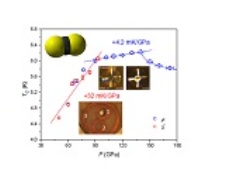Jul 2 2013
Superconductivity is a rare physical state in which matter is able to conduct electricity—maintain a flow of electrons—without any resistance. This phenomenon can only be found in certain materials under specific low-temperature and high-pressure conditions. Research to create superconductors at higher temperatures has been ongoing for two decades with the promise of significant impact on electrical transmission.
 Pressure dependence of the critical superconducting temperature of a metal created by the team from CS2 molecule (top left) was measured be electrical contacts ( inset in the middle) and electromagnetic coils (inset at the bottom).
Pressure dependence of the critical superconducting temperature of a metal created by the team from CS2 molecule (top left) was measured be electrical contacts ( inset in the middle) and electromagnetic coils (inset at the bottom).
New research from a team led by Choong-Shik Yoo at Washington State University—and including Carnegie’s Viktor Struzhkin, Takaki Muramatsu, and Stanislav Sinogeikin—found unexpected superconductivity that could help scientists better understand the structural changes that create this rare phenomenon. Their work is published the week of July 1 by the Proceedings of the National Academy of Sciences.
The team found superconductivity in the solid form of a compound called carbon disulfide, CS2, which is sometimes used in liquid form as a chemical solvent or insecticide. They found that disulfide enters a superconducting state at about -449 degrees Fahrenheit (6.2 Kelvin) at pressures ranging from about 493,000 to about 1,698,000 times normal atmospheric pressure (50 to 172 gigapascals).
“What makes this discovery special is that it seems counter to the understanding of how superconductivity normally works,” Yoo said.
Usually, but not always, superconductivity is present in highly ordered molecular structures. But in carbon disulfide, superconductivity arises from a highly disordered state, which is rare. Even more surprising, this disordered structure is preceded by a magnetically ordered state, which undergoes a structural change into the disorganized configuration when superconducting starts.
“These results show the interplay between superconductivity, magnetism and structural disorder,” Struzhkin said. “We are already at work searching for other highly conducting states in similar molecular systems in close collaboration with Professor Choong-Shik Yoo's team.”
The rest of the team was lead author Ranga Dias, and co-author Minseob Kim also of Washington State University; and co-authors Takahiro Matsuoka and Yasuo Ohishi of the Japan Synchrotron Radiation Research Institute.